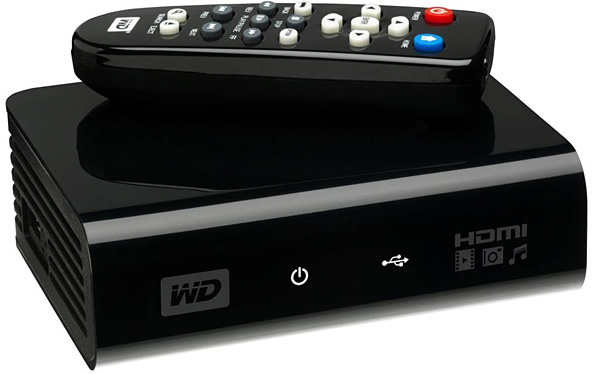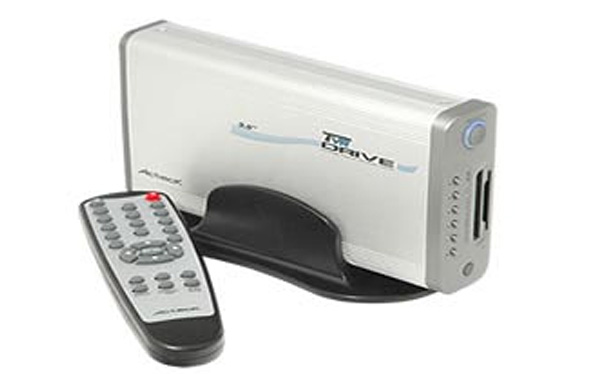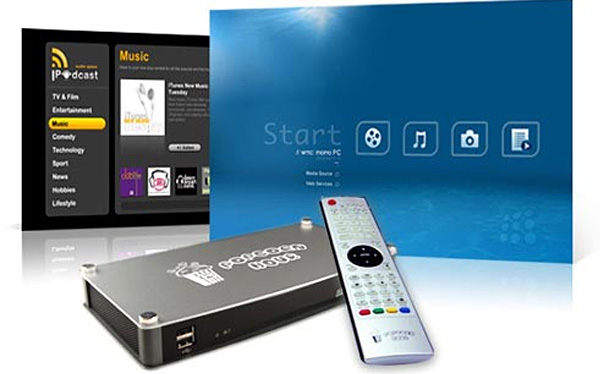
|  |  |  Technology News | December 2009 Technology News | December 2009  
Technology in the 21st Century
 Mark de Leon - TeknoGeekz.com Mark de Leon - TeknoGeekz.com
December 17, 2009

Dedicated Media Players are devices that connect to a television to play video, photo, and audio files from your computer. These can be downloaded videos, music or images and DVD rips that you make on your computer from your DVDs. Readers with small children may appreciate that they can keep the DVDs out of the hands of the little ones.

Now when the four year old wants to see the same movie for the 100th time this week, you have no fear of him taking the DVD out of the player and stepping on it! All you need to do it rip it to a computer file and use one of these devices here and play it at will. No DVDs to damage or juggle. I will specifically avoid solutions such as AppleTV and TIVO because they are proprietary in nature.

Dedicated media players come in all shapes and sizes. Some media players rely on an internally installed hard disk , while others rely on a USB connected disk or a network connection. Nearly all units offer a remote control.

Some examples of Media Player devices:


| | Western Digital HD TV . This device connects between an external Hard disk drive and your TV. This unit also does high definition via an HDMI connection to your High Definition TV (www.westerndigital.com) |  |

| | Acteck ACU-MPE35 Media derive. This unit is built into a hard disk drive case and allows the user to install an IDE drive of the size they prefer. Offers a variety of outputs including Composite, component (progressive scan), Optical and analog audio. It can also read from a variety of memory card formats. (www.acteck.com) |  |

| | PopcornHour.com offers many different models with many different features including units that connect to networks and parts to build your own system for the truly adventurous. |  |
Also there are solutions that one can built into a computer such as MythTV (Linux) and Windows XP Media Center Edition. This may be best accomplished using one of the newer mini computers because of their lower power consumption. The advantage of these PC based systems are that you can record content and use “place shifting”, and view streaming media from the web, as well as Internet radio in some cases. Of course, some add-on software may be required. So if you are a seasonal Vallarta resident, you would then be able to watch your USA Cable subscriptions from Vallarta over broadband if such a system were installed in your home in the USA. This all depends on the software and hardware you use of course. You could also retrieve recording of your favorite shows that you make from your cable connection in the USA. Because the decoding of file formats is software based on these systems, they offers better compatibility and upgradeability for new CODECs and container formats.

Another consideration is Xbox Media Center, or XBMC for Windows, Mac or Linus, as well as any Xbox, although some amount of work may be required to get it to run on your Xbox it has the ability to Network with your PCs as well. The original Xbox does not support High Definition, however is a viable alternative for many who have an old Xbox laying around. As I understand It the Xbox 360 does support High Definition. XBMC also supports some Internet Media streams which I found to be of good viewable quality over a basic Infinitum connection, and offered a good variety of programs to view. Clearly it was not something I would want to watch on a 44 inch HDTV display.

One may be surprised to learn that I also mention here DVD players. Most DVD players are capable of playing some video and audio formats. There is a growing trend to include more Media player like features on DVD players. Many basic models now offer USB ports, and some higher end units offer a network connection to more easily incorporate ripped or downloaded files into your viewing.

DVRs or Digital Video Recorders are devices that are dedicated to recording content such as off of cable or Satellite TV. Many DVRs incorporate a built in hard drive. Many of these devices may also incorporate Media Player features, such as playback of multiple formats, etc. Some DVRs are dedicated to recording security camera feeds , so be careful that you know what you are buying. If you will incorporate a DVR into an existing network with a Media player, you may want to ensure that you can easily get the files from the DVR to the Media Player, especially if the Media Player is in room A and the DVR is in Room B. This could be over a network or via an external hard drive. Also you need to ensure that your media player can handle the format, flavor and resolutions of the file written by the DVR.

If you use torrents, or emule, you can see that there is a large amount of high quality content, freely available. As a side note, I have a large collection of CDs DVDs and Video Cassettes and I download movies and music that I already own to prevent me the time consuming task of ripping them to computer files. I do not condone copyright infringement, but feel that in many cases the entertainment industry has gone way too far (after all this article is targeted to users in Mexico, where things are clearly somewhat more lenient.).

Media Formats

Each media player has a specific set of formats that it supports. First consider the CODEC , such as MP3 or DIVX. However aside from the CODEC (DIVX in this case) , one must consider the container format, such as AVI, OGM, or MKV. The file extension most often conforms to the container, and not the CODEC used. MKV seems to be an evolving container format that is well suited to HD. I have yet to see a media player that supports all container types,.

Most files however can be easily converted often without loss of quality with programs such as VirtualDubMod, MediaCoder, and ALLtoAVI, which are all freely available on the Internet. Some of these programs allow you to simply “repack” a file from one container type to another, however some containers support CODECs or compression types that are not supported by another container. For instance, I have seen OGM files that have a DIVX video stream inside of them, and the DIVX stream can be repacked in seconds into an AVI container, however the audio often found in the container OOG is not compatible with the AVI container so I must extract the audio and transcode it to a compatible format for the destination container. On the other hand I have seen MKV files with DIVX video and MP3 Audio, and I need only repack them into an AVI container with VirtualDubMod. This process is not unlike removing sugar from the bag you bought it in to the container in your kitchen to make it more readily available, and with SD formats takes just about as long. If there is some conversion of CODECs used in the streams required, it can be accomplished however may take longer.

Most players support DIVX. When I speak of DIVX , please note that I am also referring to Xvid, which as you can see the name implies DIVX in reverse because it is a reverse engineered version of DIVX. DIVX however is growing to support additional features that may not be supported in Xvid. Therefore any DIVX player also plays Xvid but an Xvid Player may not support all DIVX media features such as multiple language tracks or subtitles. And now with DIVX 7 , still newer features have been introduced that Xvid does not yet support. Most media players WILL support direct DVD copies, and you can even create smaller file sizes with programs such as DVDShrink. If the entire unencrypted DVD (or encrypted DVD copied with DVD Shrink) is copied to a folder, the original DVD features remain intact, such as languages and subtitles. Most media players will also support JPG and MP3 for those of you with extensive photo or music collections. Few hardware players support FLV, RealMedia, WMV, and ASF formats because these formats are proprietary. Also, just because a Video has the .AVI file extension or is packed in an AVI container, does not mean that it is playable, as the CODEC may be any one of hundreds of CODECs. Clearly DIVX/Xvid is one of the most popular in the download world.

Of course then there are files that although have the .AVI file extension may truly be something else. For these files a utility like GSpot is useful for identifying the file with an incorrect extension, as well as identifying the CODECs used in the video and audio streams..

Most dedicated media players are not compatible with DRM (Digital Rights Management), nor will play DRM protected files. This means that files from iTunes or other DRM protected content will not play on a media player that is not computer based. This of course is not true if you roll your own system based on a Windows PC.

High Definition vs Standard Definition

We hear a lot about “High Definition”, “High Def”, or “HD” these days. This refers to the resolution of the images. Just because you have a High Definition TV does not mean the video content you are watching is High Definition. The higher the resolution of the content you are watching the larger the file sizes. This means that if you are downloading a HD 720p DIVX movie it may be 2 Gigabytes for the same movie in standard definition 480p DIVX at 700 Megabytes. That is nearly three times the size for HD vs SD, and 720p is not the highest definition for most TVs today. Most TVs today will go to 1080p which is likely to be more than 5 Gigabytes for a similar file. That would not work so well if you were relying on Infinitum to download that file. Also, your media player needs to able to sustain high data transfer rates to achieve the necessary throughput of any high definition signal, so forget the original 802.11b wireless networking standard for HD files. Your media player also needs to support the container format, CODECs and resolution, as well as output that signal to your TV/Monitor in a way that will not degrade the quality. In most cases a component progressive scan connection is adequate, however SCART, HDMI, DVI and VGA at higher resolutions can be better.

About HDMI

HDMI is not really an advantage over analog component as far as video quality goes. Analog component is actually capable of very high resolutions, only the consumer standards have not been defined for anything above 1080i over component. Actually the higher resolution standards over component were stifled by the introduction of HDMI. Nonetheless, some manufacturers incorporate 1080p resolutions over component although it is not a clearly defined standard over component. Much like VGA, there is no defined limit as to resolution over component. The big selling point for HDMI is really not for the benefit of the consumer, rather the content producers. That is the ability to incorporate copy protection. Aside from this there are evolving standards for digital audio over the same HDMI cable. So consumers have traded the single simple HDMI connector for the ability to record HD content. HDMI, technically is capable of detecting a recording device from a display device, and the content producers and hardware manufacturers made the trade-off decision for us.

Which is right for you?

If you would rather spend a little more and not have to juggle a USB hard disk between your media player and your computer, you most probably want to consider a unit with a network interface. In this way you can access files over your network. Keep in mind however especially with high definition files you may run into issues with the speed of the network and hardware serving the files.

Navigation is also an important consideration. How do the menus work? How is the interaction with the remote control? I have seen many media players, and most do not seem to offer “natural feeling” controls, while others that do, may lack in another area such as the on screen menus.

Formats supported by the Media player is also a major consideration. I believe that the DIVX format is the best for a broad range of compatibility. Also consider the resolution of the files to be played back. If you do not need true HDTV resolution, you might want to save the money and buy a more basic unit.

What will you connect it to? If you have all High Resolution files and only want to play them Back on a regular standard resolution set, you will need to pay enough for a unit that supports higher resolution files, even though it is connected to a standard definition TV. On the other hand it you have an HDTV plasma display, you probably want to consider paying a little extra for a unit that supports higher resolution video playback. Of course HD displays will accept SD resolution content just fine.

Will the source material be content that you generate and control the format, or downloaded material that may come in a variety of containers, CODECs and resolutions?

Conclusion

Clearly the benefits of a dedicated media player are obvious. As technology advances however realize that what you purchase today , may not support the formats of tomorrow. There are constantly new containers and CODECs emerging. PC based solutions such as MythTV, Windows XP Media Center, and Xbox Media Center help to combat this built in obsolescence, but on the other hand Microsoft wants to make Windows XP obsolete ASAP. As with any technology purchase today, you will probably be replacing it within a few years so do not over-spend.

It is the consumer market that drives the entertainment industry. As the entertainment industry begins to recognize the need for unlimited view digitally delivered content, they will begin to expand their commercial offerings. The formats they choose may or may not be compatible with the technology of today. Of course all along the way they will think of new methods to protect their content and stifle personal back-ups and viewing of our own copies.

 Mark de Leon has worked 20+ years in the USA as a Video Engineer for Rogers, The Merv Griffin Group, and Trident Media Group. Later he started and ran his own VoIP company. He has presented at the “Encuentro de Sistemas” at the University of Guadalajara CUC Vallarta campus instructing VoIP. He is a full time resident of Puerto Vallarta where he has now lived for over five years. Mark can be contacted through www.teknogeekz.com or 044 322 205 5236 Cel or +1 206 203 5561 USA Mark de Leon has worked 20+ years in the USA as a Video Engineer for Rogers, The Merv Griffin Group, and Trident Media Group. Later he started and ran his own VoIP company. He has presented at the “Encuentro de Sistemas” at the University of Guadalajara CUC Vallarta campus instructing VoIP. He is a full time resident of Puerto Vallarta where he has now lived for over five years. Mark can be contacted through www.teknogeekz.com or 044 322 205 5236 Cel or +1 206 203 5561 USA
|

 |
|  |



